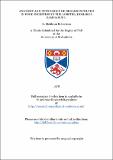Anatomy and physiology of organs involved in food ingestion in the lobster, Homarus gammarus L.
Abstract
The dissertation describes the gross neuromuscular anatomy of the labrum (upper lip) and oesophagus of the lobster Homarus gammarue as a pre-requisite for studies on the mechanisms and control of food ingestion. Sense organs of the area are also described. Of particular interest are two paired sensors (the anterior and posterior oesophageal sensors) which are bilaterally situated at the oesophageal/cardiac sac valve. These are similar to contact chemoreceptors previously described in insects, and are classified as such on morphological grounds and with indirect electrophysiological evidence. The labrum undergoes rhythmical retraction/protraction movements during feeding and can be shown to participate in both the mandibular rhythm and oesophageal peristalsis. Its role in feeding is discussed. Subsequently, small labral protractions are used as an indication of the duration and frequency of oesophageal peristalsis. Oesophageal peristalsis is effected by the co-ordinated contraction of the oesophageal musculature. This is controlled by rhythmical bursting neuronal activity which can be recorded from the nerve trunks in the area, A characteristic burst recorded from the superior oesophageal nerve is used as an indication of oesophageal dilatation during peristalsis for studies on the feedback effects of the oesophageal sensors. Electrical and chemical stimulation of the posterior oesophageal sensors can initiate and increase the frequency of oesophageal peristalsis, while stimulation of the anterior oesophageal sensors can slow and terminate oesophageal peristalsis. The results are discussed and, in conclusion, a model of the role of the oesophageal sensors in feeding is presented.
Type
Thesis, PhD Doctor of Philosophy
Collections
Items in the St Andrews Research Repository are protected by copyright, with all rights reserved, unless otherwise indicated.

